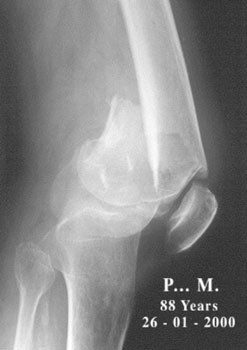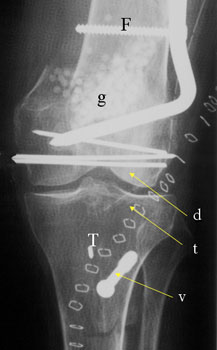Knee fracture
A severe fracture of the knee
![]() A great-grand-mother short-sighted, who drags one‘s feet, and possess many carpets. These three conditions are more than enough to involve severe complications in case of falling.
A great-grand-mother short-sighted, who drags one‘s feet, and possess many carpets. These three conditions are more than enough to involve severe complications in case of falling.
She felt from forty centimetres on the floor!
 |
What can be done for this smashed knee? A big cylindrical-shaped fragment penetrates as a wedge into the lower part of the femur and blows it up. There are many unknown answers: We are sure of only one thing: |
A very difficult fracture
 |
A very bad fall. Facing a severely osteoporotic bone, the fracture can be very complicated to treat. In this case, the cancellous bone inside the femur has almost totally disappeared. The femur is like an empty shell whose walls are thin and fragile . |
A challenge almost kept
 |
The lower femoral extremity is almost anatomical. The knee surface of both femur (F) and tibia (T) are in contact. But … the femoral shaft is not exactly in the middle of the articular joint. The cylindrical-shape of the lateral condyle (d) is not exactly above the tibial plateau. The gap (g) due to the cancellous bone compression is filled with natural coral (12 g). |
What about the lateral view?
 |
An empty egg-shell! Sometimes, it is not technically possible to replace and fix perfectly all fragments. Here, the anterior wall (a) penetrates into the cancellous bone underneath. It was not possible to remove it and fix it in proper position. As it is behind the patella, it will badly interfere with the knee motion. No technical solution is possible in that case! |
| Lower Limb pathology: Tibia |